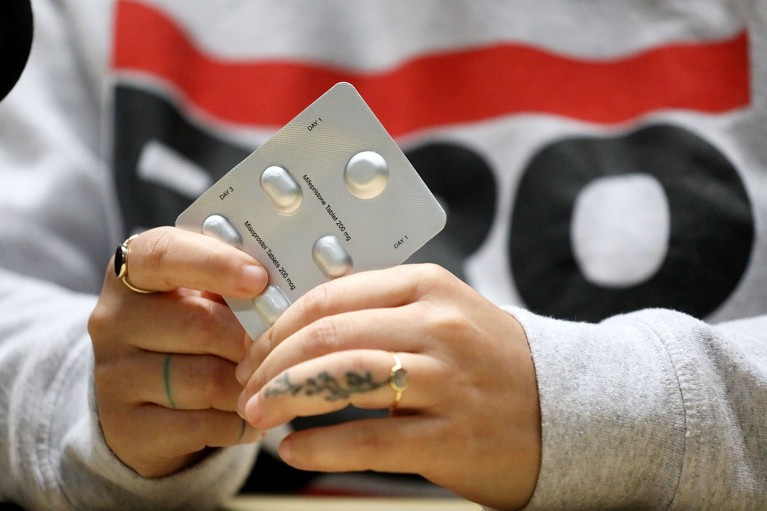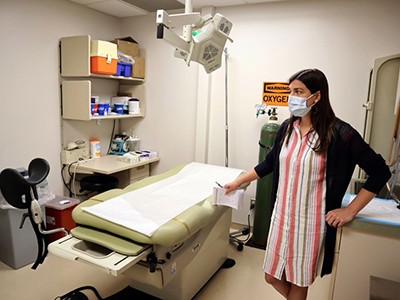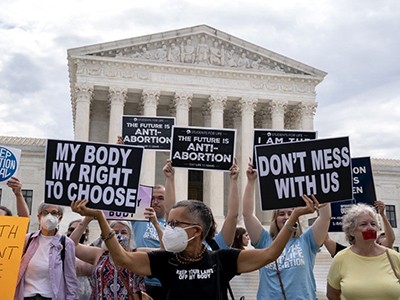
The drugs mifepristone and misoprostol are usually used in combination to terminate a pregnancy.Credit: Jakub Kaminski/East News/Shutterstock
A lawsuit in Texas not only has the potential to further restrict abortion access in the United States — but it could also set a dangerous precedent by overturning the approval of a medication by the US Food and Drug Administration (FDA).
After Roe v. Wade: US researchers warn of what’s to come
Following the reversal of Roe v. Wade last year, some US states have banned abortions, driving more pregnant people to seek medication abortions. The lawsuit against the FDA, brought by anti-abortion groups and physicians, seeks to overturn the agency’s 2000 approval of the abortion drug mifepristone. The plaintiffs allege that mifepristone, which is used in combination with another drug, misoprostol, is not safe — a claim that is not corroborated by the scientific evidence, say researchers who spoke to Nature. Legal specialists think there is a good chance that the judge deciding the case, Matthew Kacsmaryk in the US District Court for the Northern District of Texas, will rule in favour of the plaintiffs. Appointed by former US president Donald Trump, who promised to help overturn Roe, Kacsmaryk “has deep ties to the religious right, and he has issued rulings that are based on very, very conservative ideologies”, says Amanda Allen, an attorney and director of The Lawyering Project, an organization based in New York City that works to improve abortion access.
The effects of this case might reverberate across the country, further affecting health care for pregnant people. “If the plaintiffs get what they’re asking for, mifepristone will be banned in all states — it doesn’t matter if the state has a law in place that protects access to abortion,” Allen says.
Here, Nature explains the evidence in the case, what’s on the line and what abortion options will be available to people in the United States if the FDA loses.
Is mifepristone safe?
All the evidence suggests that the answer is yes, contrary to what the plaintiffs argue. A 2013 systematic review published in the journal Contraception, for example, found that failure to terminate a pregnancy occurred in fewer than 5% of pregnant people who had taken mifepristone combined with misoprostol, and only 0.3% of people were hospitalized after the treatment1. The World Health Organization (WHO) lists the regimen as safe, and so does the American College of Obstetricians and Gynecologists (ACOG).
‘We are bearing witness’: Health researchers navigate a post-Roe world
The plaintiffs also allege that the FDA made a mistake when it approved the drug in 2000 and its generic version in 2019. They say that the agency approved the drug using an accelerated process that required it to consider pregnancy an ‘illness’, for which the abortion drug would provide a ‘meaningful therapeutic benefit’. “But pregnancy is not an illness,” the plaintiffs state in their complaint.
In response to the lawsuit, the FDA’s attorneys have written that mifepristone’s approval did not involve an accelerated review (the approval process took four years). They also said that the plaintiffs do not provide any concrete example of a patient who might have suffered serious adverse events associated with mifepristone. “That omission is particularly telling, given the more than two decades that mifepristone has been in use,” the court filing says.
If the FDA loses, can people seeking abortion still use misoprostol?
Although the combination of mifepristone and misoprostol is the most commonly prescribed regimen for medication abortion in the United States, both the ACOG and the WHO say that using misoprostol by itself is a safe and effective alternative.
“Mifepristone gets so much attention because it was approved as an abortion drug,” says Cari Sietstra, a specialist in reproductive health and justice and principal consultant at Innovations in Reproductive Health Access, a non-profit organization based in Emeryville, California. It was designed to block progesterone, a hormone needed for pregnancy to continue. Misoprostol was originally approved for preventing gastric ulcers. But researchers realized that it causes the uterus to contract, bleed and expel any embryo inside.

Activists march outside the courthouse in Amarillo, Texas, where a lawsuit to ban the abortion drug mifepristone will be decided.Credit: Justin Rex/AP/Shutterstock
So it is an option for medication abortion, says Heidi Moseson, an epidemiologist based in Oakland, California, who works at Ibis Reproductive Health, a global research organization that supports abortion rights. “It’s just that clinicians in the United States have less experience providing it, because for so long the default has been the combined regimen,” she says.
Moseson was the first author of a study published last year2 in The Lancet Global Health that looked into the effectiveness and safety of medication abortion with misoprostol alone or in combination with mifepristone. The study, which followed 961 people who self-managed abortions in Argentina and Nigeria, found that 99% of those who used misoprostol alone had a complete abortion without needing surgical intervention. Among those who used the combined regimen, the rate was 94%.
Another reason why misoprostol isn’t often administered on its own is that some clinical trials have shown that it has a lower success rate, Moseson says. But that’s probably because of differences in study design and local conditions, she adds. In some studies, if after a few days of taking misoprostol the abortion is not complete, participants are offered a surgical abortion. This would then be registered as an unsuccessful use of the drug. In settings where surgical intervention isn’t readily available, the success rates tend to be higher, Moseson says.
The other issue is that some of the previous studies that evaluated misoprostol alone did not use the dosing scheme that is currently endorsed by the WHO. “There’s a lot of variation both in the results and in the regimens that are used,” says Daniel Grossman, director of Advancing New Standards in Reproductive Health, a social-sciences research group at the University of California San Francisco.
Could misoprostol eventually be banned?
It’s possible. In addition to requesting the ban of mifepristone, the Texas lawsuit invokes an 1873 law, the Comstock Act, which is still a part of the US Code. This act made it illegal to send obscene materials or articles intended for “producing abortion” through the mail. The legal team for the plaintiffs hopes to use this to prohibit the distribution of all abortion drugs by mail.
Why hundreds of scientists are weighing in on a high-stakes US abortion case
“Their first stop in this lawsuit is to go after mifepristone. But, make no mistake, the plan here is to end access to medication abortion for everyone in this country,” says Allen.
The precedent set by a court overturning an FDA approval by challenging the agency’s decision-making capacity could endanger misoprostol, too — as well as many medications beyond it, including birth control pills, COVID-19 vaccines and more.
“This really threatens the FDA’s authority over the approval process for medications across the board,” says Allen. “It really kind of flies in the face of the idea that the FDA is there because they’re the ones who have the scientific and medical expertise to make these decisions, not courts.”
What happens next?
Kacsmaryk could make a decision later this month. What happens after that depends on the ruling. If he agrees with the plaintiffs, it could trigger an immediate ban on mifepristone, or he could order the FDA to take certain steps. In the latter case, “nothing would really happen until those steps were taken. So, we’re really in a state of just waiting and seeing,” Allen says.
If such a decision were to be appealed, it would land in the US Court of Appeals for the Fifth Circuit, “one of the most conservative appellate courts in the country”, according to Allen. Assuming that the court upheld this theoretical decision by Kacsmaryk to ban mifepristone, the next option would be for the FDA to take the case to the Supreme Court.




